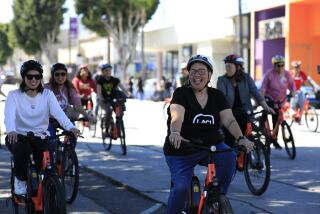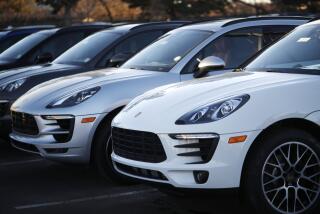Is America ready for an $8,500 three-wheeler that delivers a cardio workout?
Can-Am, the motorcycle division of the Canadian power sports behemoth BRP, already turns $350 million in global sales of its three-wheeled Spyders.
That’s a drop in the bucket compared with BRP’s $4.5 billion in overall sales, which includes Can-Am off-road vehicles and BRP’s Ski-Doo snowmobiles, Sea-Doo personal watercraft and Evinrude outboard motors.
But Can-Am has aspirations. The division expects to triple its three-wheeled revenue with the introduction of a new line of lower-priced sports trikes.
On a sunny day in September, visiting members of the company invited two dozen car and motorcycle journalists and enthusiasts for a spin around the Malibu hills on the new Can-Am Ryker and Ryker Rally.
Many were already familiar with the Spyders, upscale three-wheelers marketed largely as touring vehicles for couples, that start at about $15,000 and can climb quickly with upgrades and accessories.
They seemed excited to get some saddle time on the Ryker, a stripped-down Spyder that offers the same easy operation, with a better power-to-weight ratio and a strikingly lower price: The Ryker starts at $8,499.
Josee Perrault, senior vice president of Can-Am on-road product, said her company’s research revealed that a huge number of potential riders were interested in testing or acquiring a Spyder. What’s preventing them, she said, are the price and the complex licensing required to operate the vehicles on U.S. streets.
Can-Am’s plan to triple sales hinges on price drops of $3,600 on the Spyder F3 and $2,100 on the Spyder RT, in addition to the low price on the new Rykers, and a new $149-per-month lease plan.
But it also relies upon an outreach program to promote rider training, rider education and legislative efforts to encourage more U.S. states to allow three-wheeled vehicles to be driven with auto licenses without an additional motorcycle endorsement.
Most states categorize three-wheeled Can-Ams, Slingshots and Harley-Davidsons as either “motorcycles” or “autocycles,” and some require a motorcycle endorsement. Some also require a motorcycle helmet, but some don’t.
In California, according to Department of Motor Vehicles regulations, a standard Class C driver’s license allows motorists “to operate a motorcycle with a side car attached or a three-wheel motorcycle,” but not a two-wheeled motorcycle, which requires an M-1 endorsement. And, in California, helmets are required.
The outreach program has already increased the number of three-wheeled motorcycle training programs in North America from 10 in 2016 to more than 150 today, Perrault said, and has helped license 5,000 new U.S. riders since February.
Dealer participation and test rides, Perrault said, are essential.
“Getting butts on seats is critical to marketing this product,” she said. “If we are going to revolutionize the three-wheel market we need new riders.”
Can-Am hopes to sell or lease the Rykers. The two models feature sleek style, low profiles, automatic transmissions, highly adjustable ergonomics and two engine options: a two-cylinder 600cc and a three-cylinder 900cc version of the same Rotax engine BRP uses in many of its other products. (The 600 boasts 47 horsepower, the 900 77 horsepower. The larger engine adds $1,500 to the price tag.)
The Rykers are also shaft-driven, not chain-driven — a first for a Can-Am product — and offer rider modes to maximize fuel economy (Eco) or decrease traction control and increase riding drama (Sport).
Although they can be accessorized to accommodate passengers and allow for some light touring, the Rykers are meant to be city slickers and canyon carvers, sport bikes that will appeal to “new riders,” whom Perrault described as “ethnic, urban and younger” than the current Spyder rider, whom Can-Am said is 62 years old on average.
The Malibu riders had mixed reactions. Those who had not ridden Can-Ams before, and were not motorcyclists, seemed delighted to be out on the open road, whipping around corners as they cruised from Pacific Coast Highway to Mulholland Highway and back down again.
Those who knew the Spyders, and had spent time on traditional two-wheelers, seemed disappointed that the Rykers rode so much like trikes and so little like bikes. Indeed, compared with the free-floating sensation of cornering on a motorcycle, the Ryker required muscle and stamina, especially on the twisty Malibu mountain roads.
One rider complained he was exhausted after the first half-hour. Another observed that, unlike motorcycles, which tend to handle better at speed, the Rykers got harder to operate the faster they were moving.
Can-Am has attempted to make a virtue of this. Advertisements for the Spyder in motorcycle magazines acknowledge that the ride is a workout: “You’re damn right it’s cardio,” the copy reads.
I wouldn’t argue with that, but I had a good time on the Ryker — both the entry-level model and the Rally version, which adds hand guards, a skid plate, special tires, wheels and seat, and improved suspension. It starts at $10,999.
Though I have been a motorcycle person for 50 years, and have a slight allergy to all three-wheeled bikes, I saw immediately how the Ryker would appeal both to someone new to bikes or a veteran wanting a new experience — especially an older rider with an injury or diminished leg strength who doesn’t want to balance a touring motorcycle, or a rider whose passenger feels more comfortable on three wheels than two.
For those operators, the 23.5-inch seat height makes for easy mounting, and the “adaptive foam” seat cushion was comfortable after six riding hours. The U-fit system allows the footpeg and handlebar positions to be adjusted and personalized in seconds, and without the use of tools. The 5.3-gallon gas tank allows for a 200-mile-plus range. A glove box and two USB ports help too. An optional saddlebag has room for a full-size helmet.
The width is a little daunting. At just under 5 feet from fender to fender, the Ryker won’t allow for any lane-splitting, and might be tricky for riders accustomed to narrow two-wheelers. One of the Malibu riders miscalculated a driveway, struck a pole and took a tumble.
Can-Am is betting big on the Ryker, and has big ambitions. There are already a lot of Spyders on the road. Watch for Rykers to join them.







